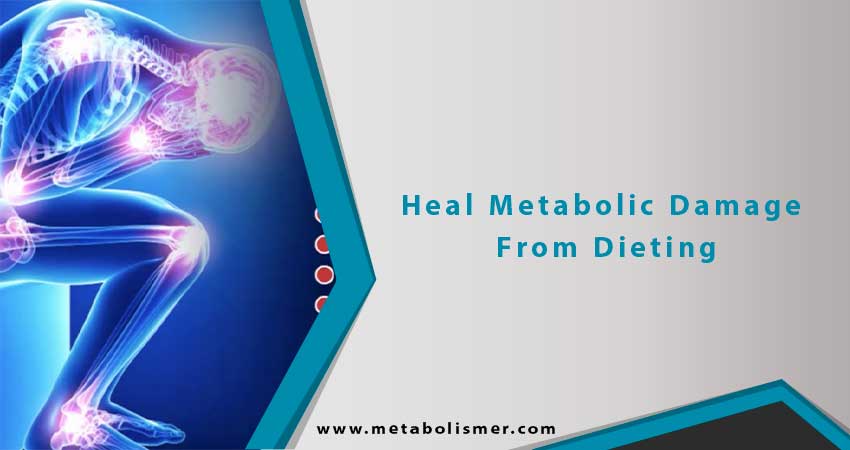HYPOTHYROIDISM AND HEART DISEASE
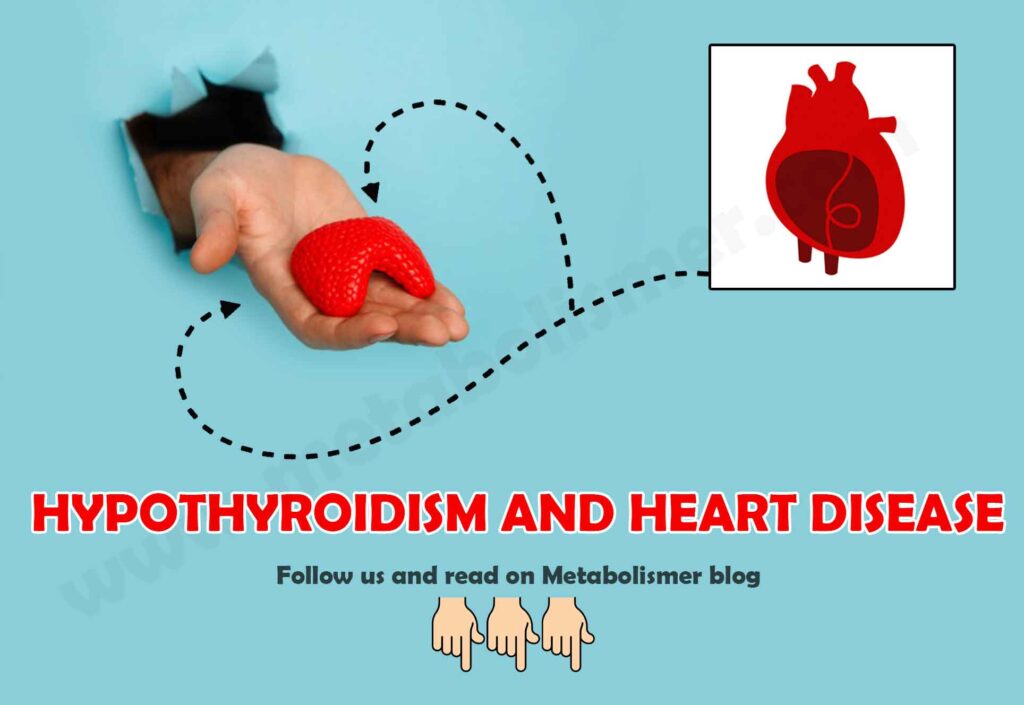
Based on a true story
It was a crazy Saturday night in the emergency room. It must have been a full moon.
I had seen everything from sore throats to snake bites and everything in between.
A nurse bolted through the door into room 3 while I was examining a young man for possible appendicitis.
She cried out, “Doctor, an ambulance has just pulled up with what sounds like another heart attack victim.”
“Get him into the cardiac room,” I said, “and I’ll be right there.”
There was a swirl of activity as the medics wheeled in an ashen, 50-something, balding man wearing a forest-green golf shirt, with an oxygen mask on his face.
They transferred him from the gurney to the examination table. The nurses rolled in with IVs and quickly started one in each arm while another nurse hooked the patient to a cardiac monitor.
Beads of sweat covered his forehead, and he had a look of both desperation and terror. “Doctor, can you help me? It feels like something is crushing my chest.”
I asked, “Do you have a history of heart problems?” “No,” he replied.
I quickly glanced at the monitor and saw that his EKG indicated the obvious. He was having a heart attack. “Give him two grams of mag sulfate IV,” I ordered.
Wading into the battle, I instructed the nurse, “Let’s slip some nitro under his tongue.
Go ahead and give him a shot of morphine.” Hopefully magnesium would regulate his abnormal cardiac rhythm and spare him from needing to be defibrillated. No sooner had I thought that then I yelled, “Get me the paddles!”
He had developed ventricular tachycardia, which required countershock therapy or else he would die. I yelled again, “Everybody stand back!”
As the paddles pressed onto his chest, I pushed the buttons on the paddles and wham! You could hear the crackle of the electricity throughout the entire room.
The EKG monitor normalized for a moment and then immediately returned to its previous abnormal rhythm.
“Charge it again. Okay, stand back!”
A second time, the paddles were placed on his chest, the current discharged, and the electricity current surged through his heart.
Silently, I prayed, “Dear God, please save this man’s life and please help me.”
Now the EKG tracing on the monitor normalized and held. I thanked God. The magnesium had taken its effect and calmed the areas of the heart that had been damaged so that they did not send off abnormal electrical pulses, which had caused the irregular heartbeats.
This occurred in the 1980s, and that is about all we had to offer a patient who was having a heart attack.
If it had happened today, he would have been given intravenous drugs to thin the blood and pharmaceutical medication to control his abnormal rhythm.
Check the metabolismer new boosting metabolism method
The cardiologist on call had been contacted and was on his way to the hospital.
The patient would stay in the emergency room until he was stable and then would be transferred to the catheterization lab where he would undergo an angioplasty in an attempt to open up his blocked coronary artery.
Both his pulse and blood pressure had returned to normal and his chest pain had subsided.

He was very fortunate. Had his abnormal heart rhythm developed at home before the paramedics had arrived, he would have become another sudden death statistic.
Forty-seven percent of cardiac deaths occur before emergency help intervenes.
The patient’s wife was standing outside the door of the cardiac room, waiting for word on her husband’s condition.
She was distraught. Her brows were furrowed and her eyes were moist and red. She was trembling. “Is he going to be okay?”
Encouraging her, I said, “Things are looking more hopeful than when your husband arrived.
He’s had a heart attack, but the cardiologist is with him now. He will be taken to the cath lab, and I feel confident that we will be able to open up his artery and take care of the problem.”
She sighed with relief.
A FAMILIAR STORY
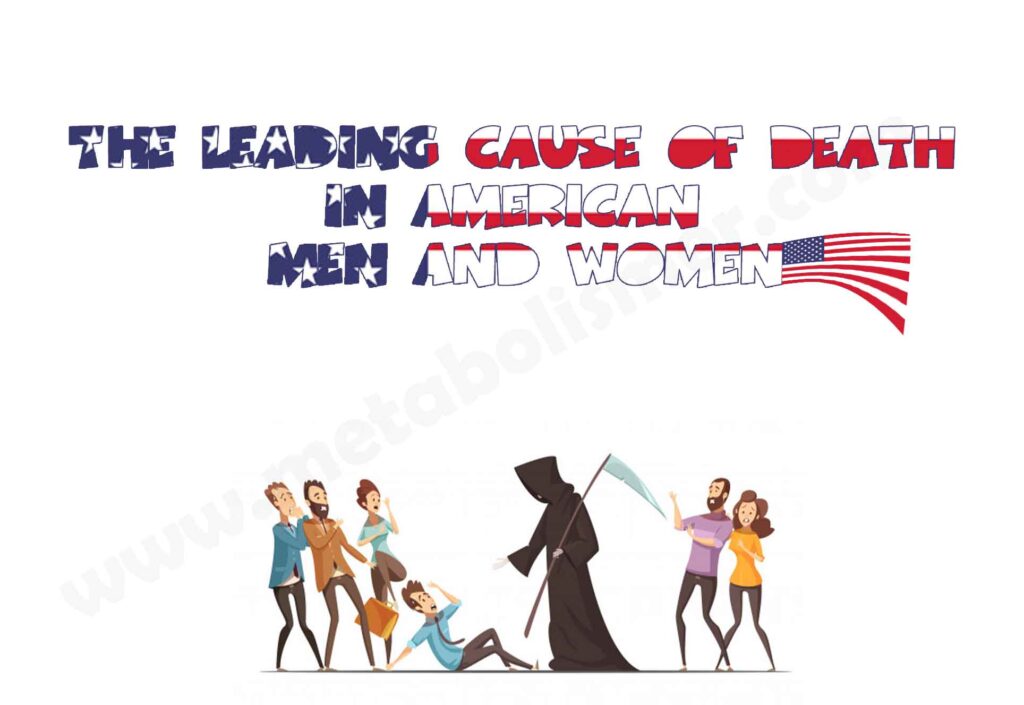
This story plays itself out again and again every day all over America. A heart attack, which is caused by blockage of the arteries of the heart, is currently the leading cause of death in America in both men and women.
This year alone, approximately 750,000 Americans will die of cardiovascular disease, which includes hypertension, strokes, heart attacks secondary to coronary artery disease, atherosclerosis of other blood vessels, and diseases of the heart. Over 400,000 of these individuals will die of heart attacks caused by coronary artery disease.
You probably know someone who died suddenly and without warning from a heart attack. It is the silent fear of middle-aged men—and justifiable because the first symptom of a heart problem is commonly a heart attack.
Annually, 1.2 million Americans will have a new or recurrent heart attack and six million hospitalizations occur each year due to cardiovascular disease. The annual price tag of health care, medications, and lost productivity due to cardiovascular disease has reached a total of $503.2 billion in 2010.
HYPOTHYROIDISM AND HEART ATTACKS
Ask the average person what they believe is the cause of heart attacks and you will most likely hear the following typical answers: diet, high cholesterol, high blood pressure, trans fatty acids found in margarine, heredity, or smoking.
While these all may play a role in coronary heart disease, the primary and yet most unrecognized cause of heart disease is hypothyroidism. If this sounds surprising, let’s first get some perspective on how cardiovascular disease gained its place as modern America’s top killer.
LOOKING BACK: THE AGE OF INFECTIOUS DISEASES
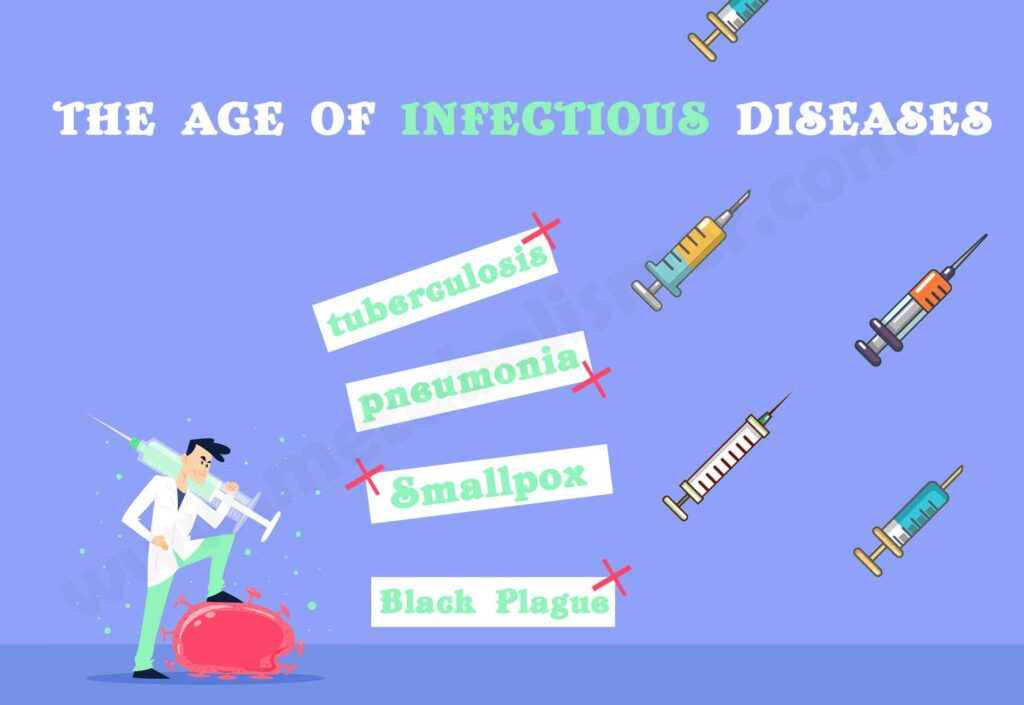
Since the beginning of time, man has been at war with diseases seeking to destroy his existence.
The Black Plague decimated the population of Europe in the Middle Ages. Smallpox led another charge, killing children at an early age until Edward Jenner, an English physician, developed a vaccine to prevent it in 1796.
Infectious diseases continued to be the leading cause of death in the Western world until the advent of antibiotics during World War II. Of the infectious diseases, tuberculosis and pneumonia ruled the roost, cutting down large swathes of the population.
Tuberculosis attacks and destroys the lungs. It is estimated that more than one-third of the world’s population is currently infected with TB, which, in its active form, kills 50 percent of victims who do not receive treatment.
Ninety percent of those infected have latent infections and remain asymptomatic. Tuberculosis earned the title, Captain of Death, because it had become the leading infectious disease causing death between 1850 and 1950.
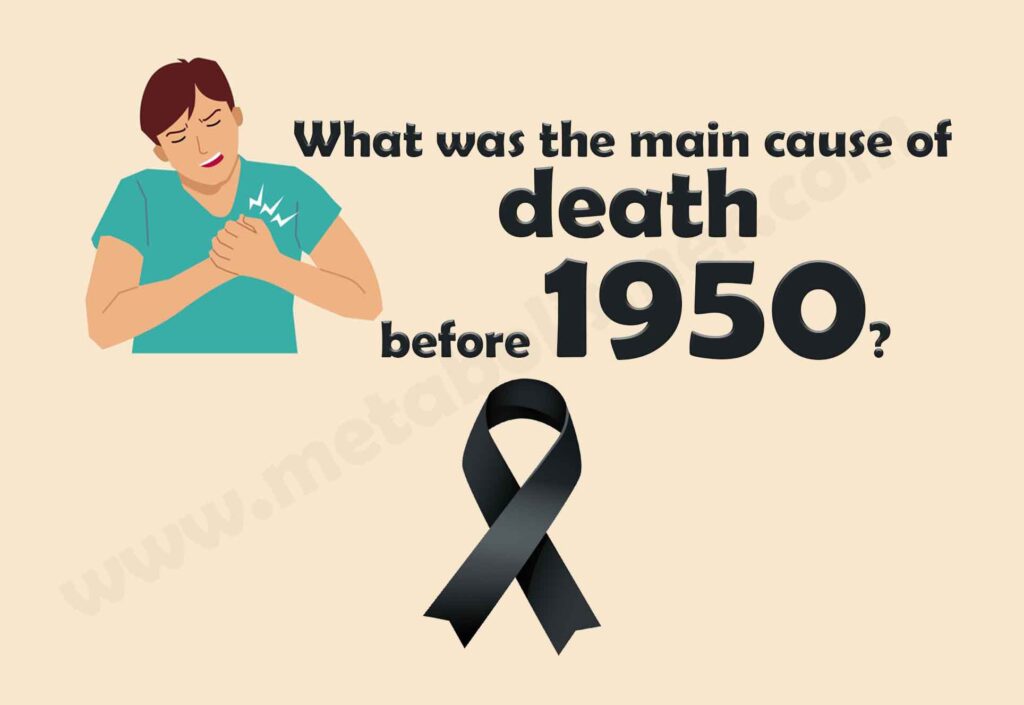
To be sure, public health measures adopted at the beginning of the twentieth century led to a reduction of tuberculosis and other infectious diseases in Western society.
However, it was the discovery of penicillin by Dr. Edward Fleming and its commercialization in 1944, as well as the development of antituberculosis drugs, that knocked pneumonia, tuberculosis, and other infectious diseases from their deadly perch.
In their place, coronary artery disease leading to heart attacks assumed the role as the grim reaper’s new Captain of Death in the 1950s.
Death patterns dramatically changed in the United States and other developed countries in the middle of the twentieth century, not as a result of changes in the environment, eating habits, or smoking, but due to the arrival of antibiotic drugs.
Now people who would have died from infectious diseases, such as tuberculosis and pneumonia, were dying from heart attacks.
What do yo know about the metabolism miracle program?
HEART ATTACKS COME TO THE FORE
Heart attacks were an uncommon occurrence prior to 1920. Angina pectoris is the chest pain caused by restriction of coronary artery blood flow to the heart muscle and was initially described by an English physician, William Heberden in 1768.37 Heberden was uncertain of the cause.
In his textbook entitled, Diseases of the Heart, published in 1913, prominent Scottish cardiologist, Sir James MacKenzie, only dedicated 15 pages to the discussion of angina pectoris.38 McKenzie attributed its cause to fatigue of the heart muscle.
He does mention that in those cases in which the death of the patient with angina pectoris occurred, autopsies often revealed plaques and calcification in some of the patients’ coronary arteries.
There is no other discussion of coronary artery disease or of heart attacks in MacKenzie’s book.
A SNAPSHOT OF MORTALITY
By way of capturing how the advent of antibiotics changed the nature of death in the United States, consider this: In 1900 in the United States average life expectancy was 47 years and the leading cause of death was infections. In 1950 the average life expectancy was 68 years and the leading cause of death was heart attacks due to coronary artery disease, the blockage of the arteries of the heart. Deaths from infectious diseases were in retreat.
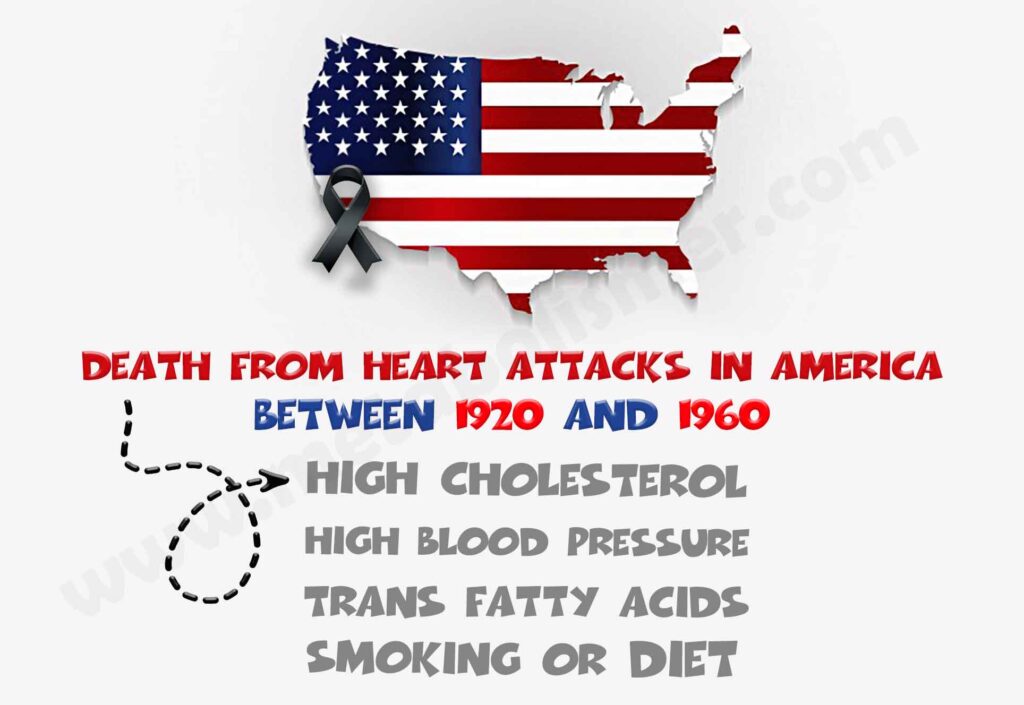
Deaths due to heart attacks were initially categorized as caused by angina pectoris in the early part of the twentieth century. Coronary thrombosis or coronary artery disease then became popular terms used to describe the same event. There was a dramatic increase in the number of deaths caused by coronary artery disease between 1920 and 1960.
Physicians and public health officials pondered this increase and came up with numerous reasons for its occurrence as mentioned earlier: diet, high cholesterol, high blood pressure, trans fatty acids found in margarine, heredity, or smoking.
AGE-OLD DISEASE
In his research of more than 70,000 autopsy reports, performed between 1930 and 1970, in Graz, Austria, Broda Barnes, MD, clearly demonstrated that coronary artery disease was not a new disease.
It was present in every individual whose cause of death was listed as tuberculosis, which was the leading cause of death in Europe at that time.
With the advent of antibiotics these tuberculosis patients were now living long enough to die of the coronary artery disease that they already had.
In 1951 Dr. J. N. Morris reported similar findings in his review of autopsies at the London Hospital in England. While the deaths due to coronary heart disease had increased sevenfold between 1907 and 1944, the autopsy findings of damaged coronary arteries had declined slightly over the same period.
It was during the first half of the nineteenth century that public health measures had been instituted.
These were already reducing the incidence of infectious diseases prior to antibiotics leading to more deaths from already present and developing coronary artery disease. Dr. Morris did not recognize the relationship between infectious diseases and coronary artery disease.
In 1985 pathologist Dr. Rodney Finlayson published his review of autopsy reports between the years 1868 and 1982 at St. Bartholomew Hospital in London, England. These reports verified what Dr. Morris had discovered 24 years earlier: deaths due to coronary artery disease increased rapidly between 1910 and 1950, but the prevalence of severe coronary artery disease had remained unchanged since the turn of the century.
Dr. Barnes’ exhaustive study clearly demonstrated that the rise in the death rate due to heart attacks between 1930 and 1970 was a result of the decline in the death rate due to infectious diseases that—as we saw in Chapter 2—were the scourge of people who were hypothyroid. Still, traditional medical opinion was not swayed.
The usual explanation given for this increase in heart disease was too much animal fats in the diet leading to elevated cholesterol, also hypertension and smoking, among others.
Maybe you interested to know about thyroid cancer
INFECTION, INFLAMMATION, AND VITAMIN C
At any given life expectancy there have always been those individuals who have lived to be much older than expected and who did not contract infectious diseases or develop coronary artery disease.
These individuals obviously have had a greater resistance to infections than others and do not readily develop coronary artery disease. But why? Could it be that the healthy production of thyroid hormones provides this increased resistance to infectious diseases and to the prevention of coronary heart disease?
It is well documented in the medical literature that coronary artery disease begins with an inflammatory process that damages the coronary arteries.
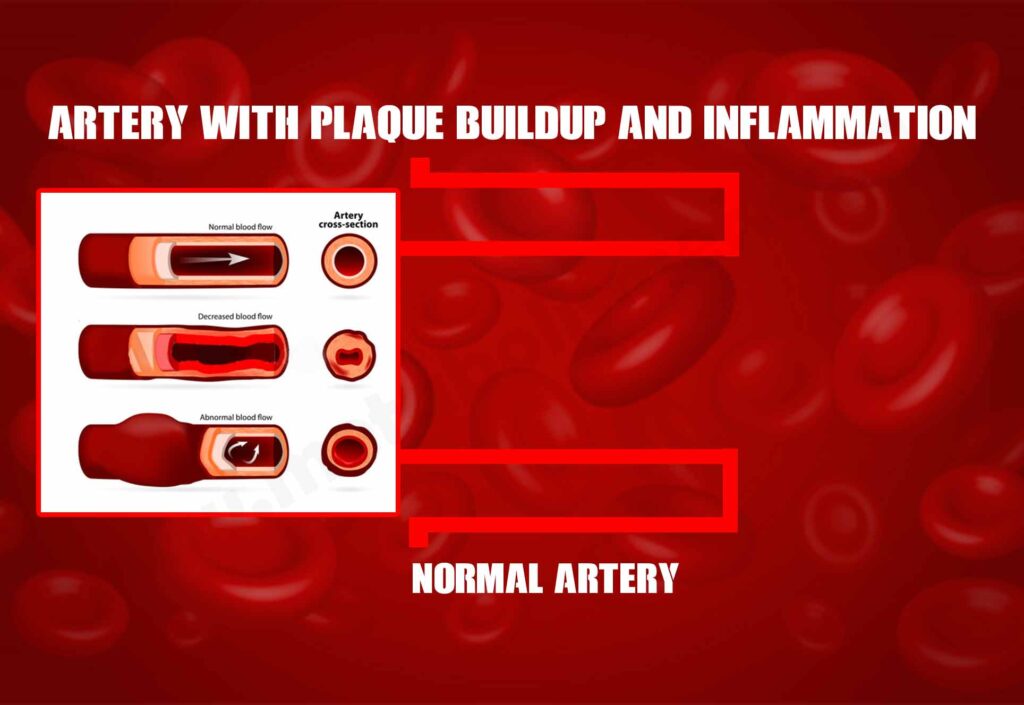
Bacteria and its antibodies have been found in the fatty deposits lining damaged coronary arteries at autopsy.
It has been theorized that bacterial and viral infections cause the initial damage to the arteries, triggering the body’s healing process to repair the damage.
If you have adequate amounts of vitamin C and the amino acids L-lysine and proline, then collagen, the intracellular protein responsible for maintaining vascular integrity, is produced, which repairs the arterial lining.
If supplies of vitamin C are inadequate, then your body is unable to make appropriate amounts of collagen to heal the arteries. Instead, it resorts to a compensatory mechanism of healing in which it uses various fat products in the blood, lipoprotein a (LPA), to patch or bandage the injury to the artery.
Dr. Linus Pauling and Dr. Matthias Rath conducted experiments on guinea pigs that indicated that coronary artery disease may simply be caused by a vitamin C deficiency.
CLUES TO A THYROID CONNECTION
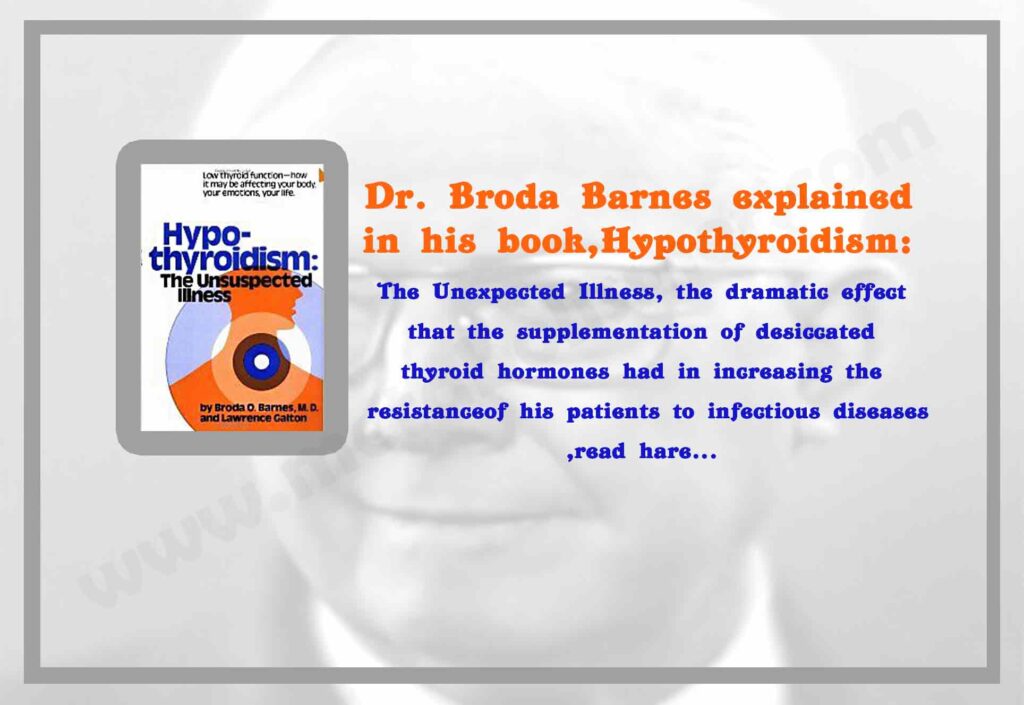
Dr. Broda Barnes explained in his book, Hypothyroidism: The Unexpected Illness, the dramatic effect that the supplementation of desiccated thyroid hormones had in increasing the resistance of his patients to infectious diseases.
He noted from a personal perspective that he had been plagued with infections throughout his life until he finally realized that he too had hypothyroidism and began effective treatment with desiccated thyroid. Dr. Barnes’ experience was the same as mine and others who have treated patients for hypothyroidism based upon their clinical history, physical examination, and body temperature, and found that their resistance to infectious diseases dramatically improved.
The cause of coronary artery disease may be secondary to the recurrent infections that plague individuals with hypothyroidism.
In 1877 Dr. William Ord, the English physician whose pioneering work on hypothyroidism was described in the Prelude, published the autopsy findings of a 58-year-old patient of his who died with classical features of myxedema, the early term Ord coined for hypothyroidism.
The report described severe disease of the coronary arteries. During the same time period, surgeons in Germany were performing thyroidectomies, the removal of the thyroid gland, from patients who had severe goiters. As noted in the Prelude, within a few months, these patients would develop myxedema and die.
But their autopsy reports also revealed severe coronary artery disease (CAD). From that time until the present there have been numerous case studies and medical articles describing the relationship between hypothyroidism and coronary artery disease.
Elevated blood pressure and cholesterol both have a significantly increased incidence in individuals with hypothyroidism. Other risk factors for developing coronary artery disease, homocysteine and C-reactive protein (CRP), are also elevated in patients with hypothyroidism. Hypothyroidism decreases the heart’s ability to contract forcefully and causes a low cardiac output state, which can lead to congestive heart failure.
Studies have demonstrated the benefit of supplemental thyroid hormones in patients who have had hypothyroidism and angina. Not only is the angina improved in more than 90 percent of the patients but the death rate is decreased.
BRODA BARNES’ STUDY OF HYPOTHYROIDISM AND HEART DISEASE
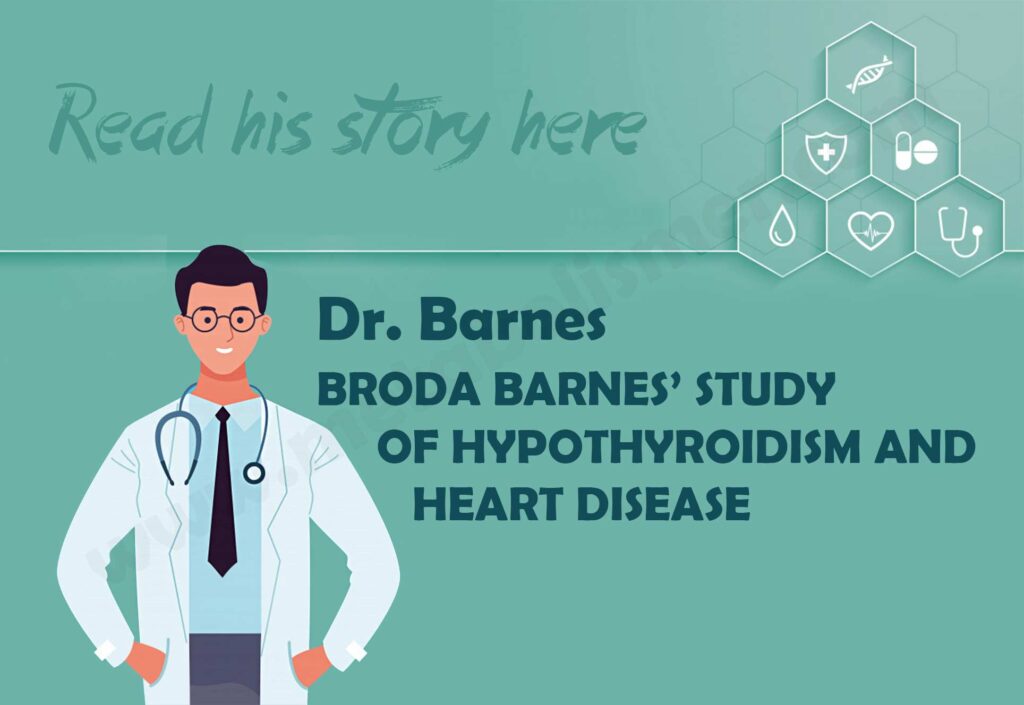
Dr. Barnes was a brilliant scientist. When a friend of his experienced a heart attack in 1950, Dr. Barnes reviewed his medical history, searching for clues.
He found that his friend had suffered from symptoms of hypothyroidism for years but had not sought treatment. Could this have been a factor in his heart attack?
Dr. Barnes knew there was a relationship between hypothyroidism and high cholesterol and realized that his patients who were being treated for hypothyroidism had a remarkably low rate of heart attacks, despite the fact that the incidence of heart attacks was rising in the general population.
This observation led him to conduct a 20-year study of the relationship between supplemental desiccated thyroid hormone and reduced risk of heart attacks.
He was fortunate to have a landmark study against which to compare the heart attack rate in his own patients: The Heart Disease Epidemiology study, also known as the Framingham study,44 which began in 1949 under the sponsorship of the National Heart Institute and which continues to this day.
In this study, five thousand residents of Framingham, Massachusetts, were selected to be followed medically for the rest of their lives in order to determine the cause of heart disease.
Each person was followed with annual medical examinations and blood work. Their diet, smoking habits, and lifestyle were documented. However, these patients did not receive supplemental thyroid hormone.
In 1970 Dr. Barnes had 1,569 patients on natural thyroid hormone who were observed for a total of 8,824 patient years.
These patients were classified by age, sex, elevated cholesterol, and high blood pressure, and compared to similar patients in the Framingham study.
Based on the statistics derived in the Framingham study, 72 of Dr. Barnes’ patients should have died from heart attacks. However, only four patients had done so. The heart attack death rate decreased 95 percent in patients who received natural desiccated thyroid hormone, a truly remarkable finding.
James C. Wren, MD, a Maine physician, published a similar study in the Journal of Geriatrics Society in 1971.45 This five-year study was conducted on 347 patients who had documented coronary artery disease.
Only 9 percent of the patients were hypothyroid by laboratory tests alone. All 347 patients were treated with desiccated thyroid hormones in physiologic doses. Cholesterol levels in this group fell by 22 percent. The mortality rate fell by 42 percent of the expected rate.
The heart attack death rate decreased 95 percent in patients who received natural desiccated thyroid hormone, a truly remarkable finding.
THE CHOLESTEROL FALLACY
Elevated cholesterol, a common feature of hypothyroidism, is considered a risk factor for developing coronary artery disease.
A recent study in the European Journal of Endocrinology, known as the HUNT study, revealed that individuals had increasing levels of cholesterol even when the thyroid stimulating hormone (TSH) levels fell within the normal range.
As early as 1934, Lewis M. Hurxthal, MD, a Boston pathologist at the Lahey Clinic, recognized the relationship between hypothyroidism and elevated cholesterol levels.
It was so pronounced that Dr. Hurxthal considered its presence as an indication that the patient had hypothyroidism and should be treated with desiccated thyroid unless another cause could be found.
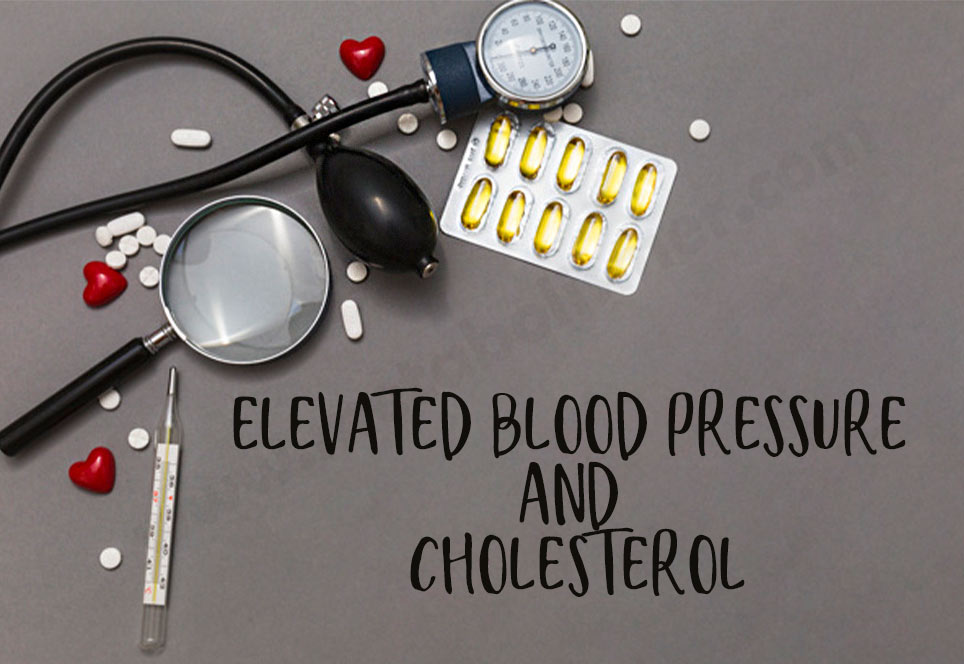
Dr. Barnes published a study in the August 1959 English medical journal, Lancet. In the study, he treated 80 patients whose cholesterol was elevated above 200 with desiccated thyroid. In every case, cholesterol levels were reduced.
In his monograph entitled, Thyroid Function and Its Possible Role in Vascular Degeneration, Professor William B. Kountz demonstrated the cause and effect relationship between hypothyroidism and coronary artery disease.
His study demonstrated the effectiveness of using desiccated thyroid hormones, which significantly increased the life expectancy of those taking the desiccated thyroid hormone compared to a control group.
Doctors often recommend that patients with an increased risk for heart attack take a daily aspirin, cholesterol-lowering drugs such as Lipitor, and beta-blocker blood pressure medication to reduce their incidence of heart attacks.
Why not consider using daily, natural, desiccated, thyroid hormone supplementation, which reduces cholesterol and decreases the death rate from heart attacks by as much as 95 percent?
















